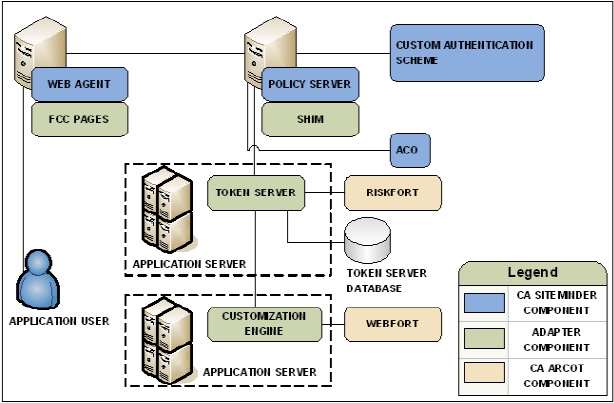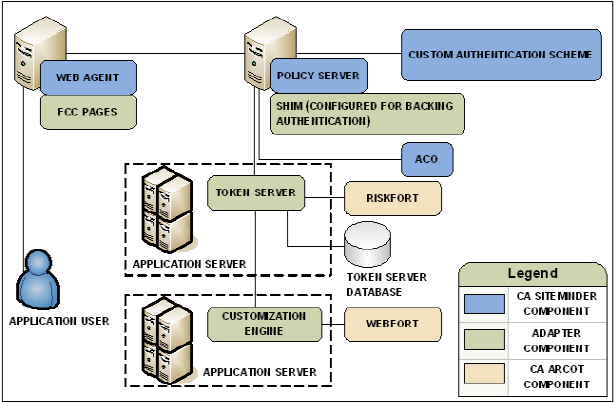

The simplest deployment includes integrating the Adapter and all related components with SiteMinder.
The Adapter guides users through the authentication (CA Arcot WebFort) and risk evaluation (CA Arcot RiskFort) processes to apply a risk score during authentication.
To deploy Arcot authentication and risk analysis
Note: For more information, see the respective CA Arcot installation and deployment guide.
Note: For more information about installing and configuring the Adapter and all related components, see the CA Arcot Adapter for CA SiteMinder Installation and Configuration Guide.
Note: For more information about the required custom authentication scheme and ACO settings, see the CA Arcot Adapter for CA SiteMinder Installation and Configuration Guide. For more information about configuring an authentication scheme and ACO parameters, see the Policy Server Configuration Guide.
The following diagram illustrates this deployment scenario:

You can configure the Adapter for risk evaluation only by integrating a SiteMinder authentication scheme. A SiteMinder authentication scheme that is part of the integration is known as backing authentication.
If you use a SiteMinder authentication scheme as backing authentication, the Shim acts as an interface between SiteMinder and the SiteMinder authentication scheme.
Note: For more information about backing authentication, see the CA Arcot Adapter for CA SiteMinder Installation and Configuration Guide. Not all SiteMinder authentication schemes are supported for backing authentication. For more information, see the r12.0 SP3 SiteMinder Platform Support Matrix.
Follow these steps:
Important! The integration requires that a SiteMinder Custom authentication scheme is configured. The SiteMinder Custom authentication scheme calls the required Adapter library. This library is required even if you are deploying backing authentication.
Note: For more information about user flows and the corresponding parameter values, see the CA Arcot Adapter for CA SiteMinder Installation and Configuration Guide. For more information about configuring a SiteMinder Custom authentication scheme, see the Policy Server Configuration Guide.
Note: For more information about configuring a backing authentication scheme, see the CA Arcot Adapter for CA SiteMinder Installation and Configuration Guide.
The following diagram illustrates this deployment scenario:

|
Copyright © 2012 CA.
All rights reserved.
|
|